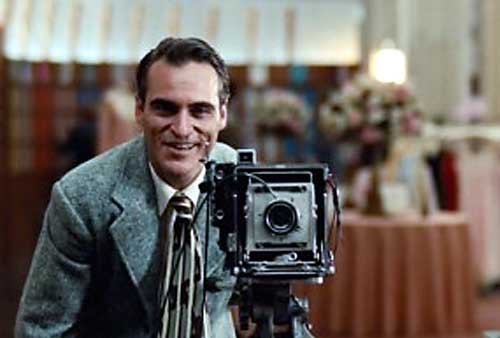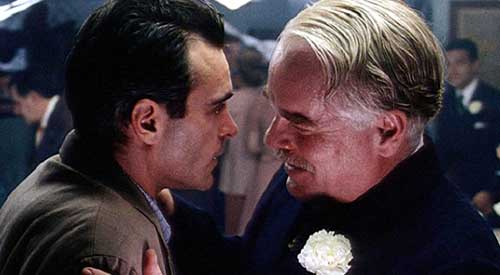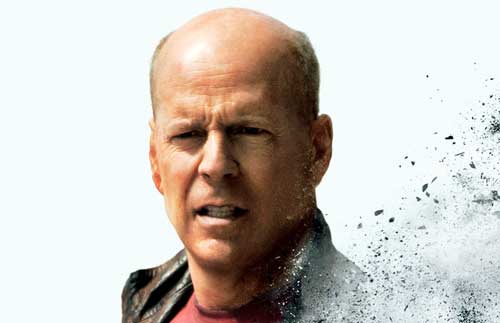|
Paul Thomas Anderson and Rian Johnson are two of the most fascinating film directors working today. Stylistically, they couldn't be more different. Anderson's films are sprawling, inconclusive, and difficult to summarize, more like certain modern novels than any movies currently being made, at least in America. Johnson's films are highly concentrated and defiantly stylized, flaunting the most eclectic, encyclopedic use of cinematic tropes since the advent of Martin Scorsese.
Nevertheless, Anderson and Johnson also share important qualities as filmmakers. Both consistently attract great actors to their projects, and elicit great performances from them. Each has an unerring visual sense and an idiosyncratic pictorial style, unique to him. Both are addicted to mystifying their audiences (i.e. the rain of frogs in Magnolia and the obscure teen-gangster slang in Brick). Both have large bands of followers that verge on cults, with an equal number of virulent detractors.
Most of all, both Anderson and Johnson have a talent for creating singular characters—characters who are both loners and larger than life. They enjoy recording the odysseys of these strange, sometimes repellent characters as they quest after wealth, wisdom, love, justice, peace of mind. They take particular joy in recording the collisions when these characters meet, always at cross-purposes, always fighting for dominance.
In Anderson's last movie, There Will Be Blood, there was never any question that the feral, mythic Daniel Plainview (Daniel Day-Lewis) would eventually defeat the sanctimonious, self-deluding Eli Sunday (Paul Dano). In his latest, The Master, the fight between cult leader Lancaster Dodd (Philip Seymour Hoffman) and would-be acolyte Freddie Quell (Joaquin Phoenix) is much more of an even match.
The Master begins with Freddie as a shell-shocked sailor at the end of World War II, with a minor talent for photography and a major one for concocting potent potables from whatever he has at hand. (Lysol, paint thinner, developing chemicals? All grist for Freddie's gin mill.) Sex is at the front of Freddie's mind, all the time. We first see him humping a sand effigy of a naked woman; a little later, administered a Rorschach test by a Navy psychologist, all Freddie can see is genitalia.
After severe misadventures as a department-store photographer and a migrant farm worker, Freddie stows away on a yacht that turns out to be Dodd's. Dodd—leader of a movement known simply as "The Cause"—is immediately drawn to Freddie, and even more to Freddie's gifts as a mixologist.
Dodd's affection for Freddie is not shared by Peggy (Amy Adams), Dodd's steely young wife, or Dodd's grown children from a previous marriage. They voice their suspicions to Dodd—that Freddie is insane, a troublemaker, possibly even a spy for enemies of The Cause. Freddie's heavy drinking and violent behavior don't exactly calm their misgivings; Dodd has to admit that even he, a genius at manipulating people, finds Freddie hard to handle. Nevertheless, Freddie accompanies Dodd and The Cause across America, serving as the group's official photographer and unofficial enforcer.
 |
Anderson drew material from certain aspects of the life of L. Ron Hubbard, but if you think this will be a movie about Scientology, forget it. In the end, The Master is about the bizarre, co-dependent relationship that develops between Freddie and Dodd. They are two distinct types found across American history. One seeks to bind people to him; the other cannot be bound, no matter how much he wants to be. Freddie beats the stuffing out of Dodd's opponents, but then he dissolves in tears, fearing they are right. As for Dodd, his feelings toward Freddie constitute a grotesque, vaguely homoerotic parody of the Biblical parable of the shepherd and the lost lamb. "In our next life," Dodd tells Freddie in a scene toward the film's enigmatic end, "you will be my sworn enemy, and I will show you no mercy." And then, Dodd starts to sing, "I'd Like to Get You on a Slow Boat to China."
 |
The Master is just as tough to summarize as any of Anderson's other movies, and in any case it is imperative to preserve the shocking surprises Anderson has in store. (Hint: you'll never regard the old folk song, "I'll Go No More A-Roving," the same way again.) As always with an Anderson film, the technical credits are superb; particularly fine are the score by Jonny Greenwood and the photography by Mihai Malaimare Jr. But what you will mostly remember from The Master are the extraordinary performances of Phoenix, Hoffman, and Adams. Two scenes in particular—the aforementioned "sworn enemy" scene, and another showing Freddie and Dodd in adjacent jail cells—are textbook examples of two great actors at the height of their powers, playing off each other with magnificent assurance.
Johnson gives us similar examples—this time with Bruce Willis and Joseph Gordon-Levitt—in his latest film, Looper. But whereas Anderson portrays two contrasting characters in conflict with each other, Johnson—through an exceptionally clever, resonant science-fiction idea—depicts a character literally in face-to-face conflict with himself.
Looper opens with Joe (Gordon-Levitt), a young man standing in a Kansas field with a sawed-off shotgun in one hand and a pocket watch in the other. Spread before him is a white sheet that will, in a second, become a winding sheet. A screaming, kneeling man, bound and hooded, suddenly appears on the sheet. Joe shoots him dead.
Welcome to 2044, when America is in total collapse and the sum total of job opportunities are hit man, hooker, or hobo. Joe is a "looper"—i.e. a hit man whose job is to kill people the mob sends back from 2074 via time travel. All such hits are of course untraceable, and Joe and his fellow loopers are paid with silver bars strapped to their victims. Joe and his pals spend their time between hits hot-rodding around Kansas City, running over the 99 percent of the population living on the streets, taking drugs in the form of eye drops, and getting laid.
There is only one drawback to Joe's sybaritic lifestyle. Sooner or later, he and all the other loopers are expected to "close the loop"—i.e. end their contracts by killing their thirty-years-older selves. This is a detail that The Rainmaker, the capo di tutti capi in 2074, insists on. To fail this task means that you still die in 2044, only without the extra thirty years.
Joe and the other loopers don't worry much about closing the loop. As Joe admits, looping doesn't attract the sanest types. But one day Joe is standing in the field, and the figure that appears on the sheet is inexplicably minus a hood. The figure (Willis) slowly raises his head, and Joe finds himself staring into his own eyes…
 |
Looper is reminiscent of any number of past sci-fi films—12 Monkeys (one of Willis' past films), Inception (one of Gordon-Levitt's), The Terminator, Blade Runner, Children of Men, even Lang's Metropolis if you want to go back that far. But Looper delves more deeply than most into the questions of identity, morality, love and self-sacrifice that arise from its story. Sci-fi and action fans will find nothing lacking here; Johnson knows how to film action scenes, and Willis, Gordon-Levitt & Co. certainly know how to play them. But it is the characters that will haunt you, particularly Young Joe and Old Joe as they stare each other down in a roadside diner—one hating the man he's become, the other filled with contempt for the boy he once was.
Both Willis and Gordon-Levitt give thrilling performances, but Gordon-Levitt has the more difficult role. Fitted with facial prostheses to make him look like Willis (though personally I think they make him look more like Joaquin Phoenix), Gordon-Levitt must make himself believable as the young Willis. (Willis recorded Young Joe's monologues so Gordon-Levitt could practice the tone and cadences of his speech.) All traces of his Brick-era baby fat gone, Gordon-Levitt does a remarkable job of capturing Willis' voice, his movements, and especially his facial expressions, which the best prosthetics in the world can't fake.
Looper is filled with throat-catching surprises, and anyone who reveals them deserves to be looped himself. The technical credits are impeccable; special mention should go to Ed Verreaux (production designer), Steve Yedlin (Johnson's usual photographer), and Nathan Johnson (Johnson's cousin and usual composer). Willis and Gordon-Levitt are backed by a cast as remarkable as they are. It includes Paul Dano, Noah Segan and Garret Dillahunt as Joe's fellow loopers; Jeff Daniels as Abe, the mob boss in Kansas City in 2044, an intriguing mixture of Tony Soprano and Dude Lebowski; Emily Blunt as Sara, a young farm woman trying to protect her small son, Cid; and little Pierce Gagnon as Cid, who (without giving away plot points) is an amazing mixture of the adorable and the creepy. Fans of Looper who see Gagnon on the street may well be torn by conflicting urges to hug him and run away from him.
|